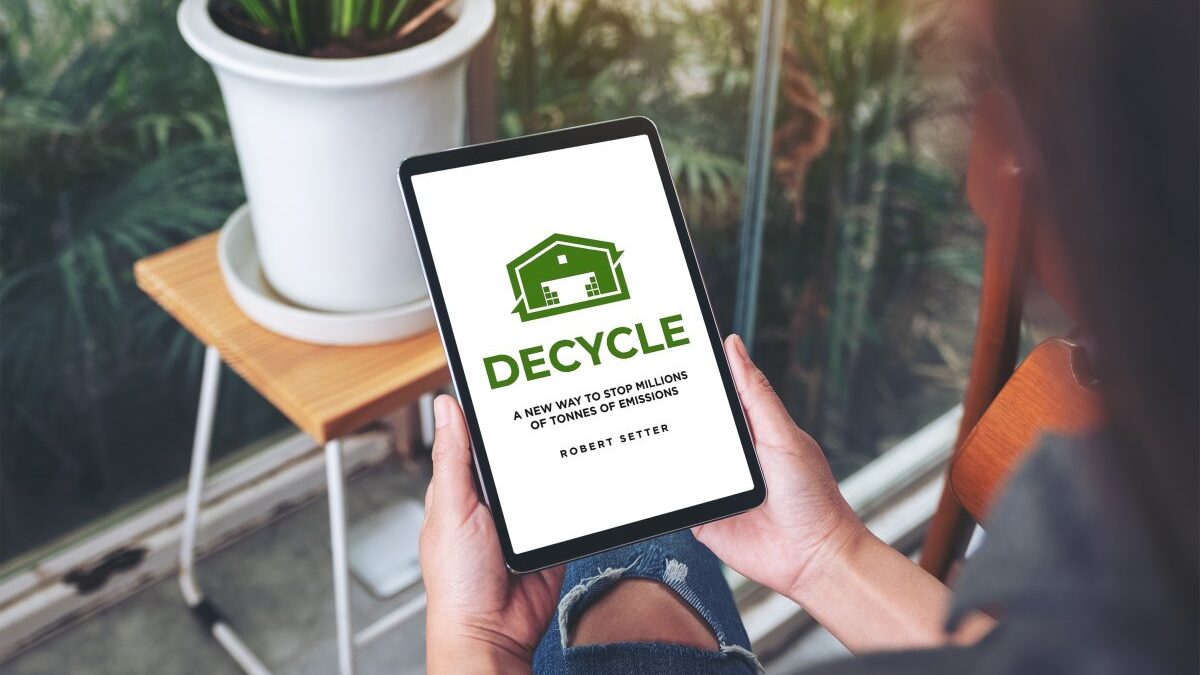Decycle by Robert Setter
A New Way to Stop Millions of Tonnes of Emissions
Decycle offers a comprehensive exploration of innovative solutions to fight global warming, combining hope, reality checks, and practical initiatives for reducing emissions and saving resources.
Decycle is a must-read for anyone interested in new practical solutions to combat global warming.
Part one provides reasons for hope as a counterbalance to the daily barrage of depressing climate-related narratives that are negatively impacting young people in particular.
Part two is a reality check that looks back to a simpler time and out into the cosmos. Are we less “green” now than in the 1950s, and can humans really control anything the vastness of space might deliver to the planet? Section three examines the transition, reviewing the pros and cons of a dozen green initiatives now underway. Most have merit, but do come with associated carbon emissions and pollution costs.
Part four covers the origin of Decycle and how it evolved, including a brief analysis conducted on a Canadian city that clearly shows the number of tons of emissions that can be stopped. Small adjustments to existing systems will reduce emissions while saving money for cities and taxpayers. If you genuinely want to get involved in novel solutions, the opportunity to do so is in your hands. It's time to Decycle.
Excerpt from Decycle © Copyright 2023 Robert Setter
The time is right, if not overdue, for innovative, practical solutions to directly address global warming. I have watched hundreds of news stories, investigative reports, and read dozens of articles on the topic, and am consistently struck that so many end the same way. After articulating the case that concrete action is needed to avert flooding, fires, and droughts, including the financial costs and impact on humans, invariably, at the conclusion, the plea is for novel solutions to help the planet.
On April 4, 2022, the Intergovernmental Panel on Climate Change released a report based on roughly 18,000 studies, approved by 195 countries concluding carbon emissions need to peak by 2025 and fall by 43% by 2030 to limit global warming to 1.5 degrees Celsius. Point five of the report for action notes a reduction in material consumption is one of the central tenets.
This book covers an implementable practical solution that requires little capital or decades of study to achieve two goals: permanently stopping carbon emissions and saving money as city collection expenditures are reduced. In summary, Decycling intercepts the circuitous route recycled material currently takes. Consumers and cities can stop chauffeuring their waste material around town and instead leave excess packaging at the point of purchase, where it can be processed within existing transportation infrastructure. Decycling includes the participation of consumers in waste diversion that will permanently stop greenhouse gas emissions. The broader the scope of adoption around the globe, the greater the amount of carbon emissions stopped.
The adoption of Decycling by Europe and North America alone would save 2.5 million tonnes of carbon emissions per year.
At this point in our economic evolution, it makes sense to identify embedded inefficiencies in current systems where relatively minor adjustments can yield significant measurable results in reducing pollution and carbon emissions. The Decycling difference compared with other initiatives is cost. Carbon capture schemes, solar, wind, and electric transport are expensive. All of the aforementioned initiatives have merit, and are being utilized, however, costs tend to be prohibitive which inhibits robust uptake. Most produce waste at the end of their life cycle which creates yet another environmental challenge. It is time we stopped the outdated practice of chauffeuring waste material all over town.
One aspect of this book is to reframe where we are now and leave the reader more hopeful about the future. It is well documented that young people, specifically, are increasingly moored in a sense of anguish and anxiety given the constant barrage of news that global warming could threaten their way of life and life on earth in the coming decades. The points covered in section one aim to help ease the anxiety and create at least a modicum of hopefulness; it is not too late, much can still be accomplished.
Section two is a reminder of where we are in the grand scheme of the cosmos and includes a look back at practices that were actually very “green.” Section three reviews many of the current initiatives; all help and have value but are costly and come with hidden emissions along with end of life disposal issues. Nothing is flawless; however, there are many current technologies and new ones coming that will help deliver the needed changes. Section four details what it means to Decycle including an estimate of the carbon emission savings possible.
There is no reason to think we can’t get there; humans have been remarkably effective in finding solutions and acting when the stakes are understood. Decycling intersects embedded inefficiencies as a practical innovation that does not require large capital investments. Most importantly, Decycling involves the participation of all of us — the consumers.
“The main affliction of our modern civilization is that we don’t know how to handle the suffering inside of us and we try to cover it up with all kinds of consumption”. Thich Nhat Hanh
My profession is online marketing and development (10+ years experience), check my latest mobile app called Upcoming or my Chrome extensions for ChatGPT. But my real passion is reading books both fiction and non-fiction. I have several favorite authors like James Redfield or Daniel Keyes. If I read a book I always want to find the best part of it, every book has its unique value.







